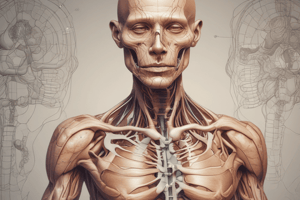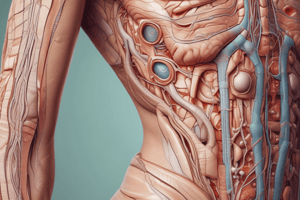Podcast
Questions and Answers
What is the characteristic of the venous pattern?
What is the characteristic of the venous pattern?
- It is limited to the arterial system
- It is often variable (correct)
- It is always consistent
- It is only found in the lymphatic system
What is the function of lymph nodes in the lymphatic system?
What is the function of lymph nodes in the lymphatic system?
- To produce tissue fluid
- To drain into the arterial system
- To collect lymphatic vessels
- To filter lymph (correct)
What is the name of the structure that collects tissue fluid in the lymphatic system?
What is the name of the structure that collects tissue fluid in the lymphatic system?
- Vein
- Lymphatic vessel (correct)
- Lymph node
- Artery
What is the ultimate destination of lymph in the lymphatic system?
What is the ultimate destination of lymph in the lymphatic system?
What is the purpose of anastomotic connections in the venous system?
What is the purpose of anastomotic connections in the venous system?
What is the relationship between the lymphatic system and the venous system?
What is the relationship between the lymphatic system and the venous system?
What is the function of lymphatic vessels in the lymphatic system?
What is the function of lymphatic vessels in the lymphatic system?
What is the structure that connects lymphatic vessels and lymph nodes?
What is the structure that connects lymphatic vessels and lymph nodes?
What is the origin of tissue fluid in the lymphatic system?
What is the origin of tissue fluid in the lymphatic system?
What is the purpose of the lymphatic system?
What is the purpose of the lymphatic system?
Flashcards are hidden until you start studying
Study Notes
Basic Structures I
- The human body consists of chemicals, cells, tissues, organs, and systems that work together to form the entire organism.
- The skin is the body's largest and heaviest organ, consisting of two layers: the epidermis (superficial layer) and the dermis (deep underlying layer).
Skin
- The epidermis contains keratin, a protein that toughens the skin, and keratinocytes, which produce keratin.
- The epidermis also contains melanin, a natural skin pigment that determines hair, skin, and eye color in people.
- The dermis is a layer of connective tissue that contains fat, nerve, and vessel.
- Skin appendages include hair, nails, and cutaneous glands (sebaceous and sweat glands).
Deep Fascia
- The deep fascia is a layer of dense connective tissue that lies beneath the subcutaneous tissue.
- Inward extensions of the deep fascia form the intermuscular septa, which separate muscles.
Muscle
- Muscle is a tissue that generates tension through contraction.
- There are three types of muscle: smooth muscle, cardiac muscle, and skeletal muscle.
- Smooth muscle is found in organs and blood vessels, cardiac muscle is confined to the heart, and skeletal muscle is responsible for voluntary movements.
Muscle Structure
- A muscle cell is also known as a myocyte.
- Skeletal muscle cells are long and threadlike, and are bound together into bundles or fascicles.
- The connective tissue of the muscle includes the epimysium, perimysium, and endomysium.
Tendons
- Tendons are formed by the collagen fibers of the epimysium, perimysium, and endomysium, and connect muscles to bone, cartilage, or skin.
Blood Vessels
- The cardiovascular system consists of the heart and blood vessels.
- There are three types of blood vessels: arteries, capillaries, and veins.
- Arteries are thick-walled and carry blood away from the heart.
- Capillaries are the smallest vessels and allow for exchanges between the blood and tissues.
- Veins contain unidirectional valves that direct the flow of blood towards the heart.
Lymphatic System
- The lymphatic system collects tissue fluid through open-ended channels called lymphatic vessels.
- Lymphatic vessels drain into aggregations of lymphoid tissue (lymph nodes), which filter lymph.
- Lymph eventually drains into the venous system.
Studying That Suits You
Use AI to generate personalized quizzes and flashcards to suit your learning preferences.




